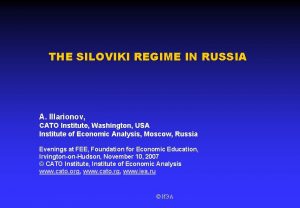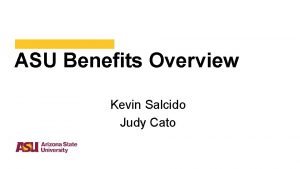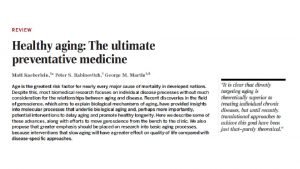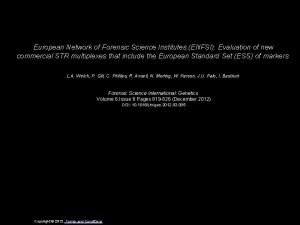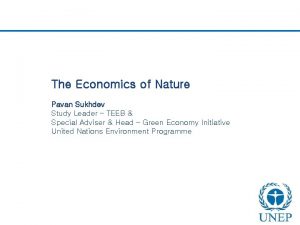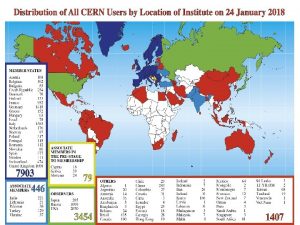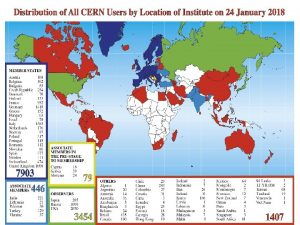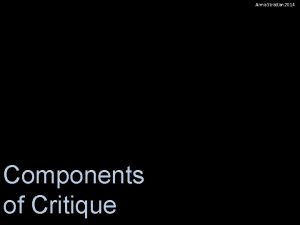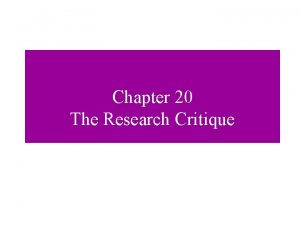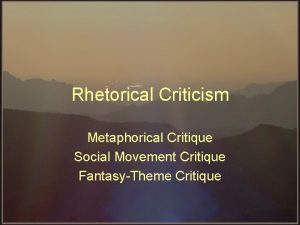WWF A Critique of The Cato Institutes Critique


















- Slides: 18

WWF A Critique of The Cato Institute’s Critique of The World Wildlife Fund’s “Living Planet 2002” Report

Background (General) n n n The July 9, 2002 release of the World Wildlife Fund’s third “Living Planet” report - which asserts that the human race is currently consuming resources at a rate 20% percent greater than the Earth’s ability to regenerate - coincided unsurprisingly with the simultaneous release of two counter-dispatches by the Cato Institute. In conjunction with an additional counter-argument published in the Cato Institute’s August 26 edition of “Policy Analysis, ” these two dispatches serve as a fairly accurate example of Conservative/Libertarian criticisms of the environmentalist movement or at least as examples prominent enough to merit scrutiny. The August 26 piece, written by Jerry Taylor, draws heavily on evidence presented by Patrick J. Michaels, a professor of meteorology whom William K. Stevens of the New York Times regards as arguably one of “the two most persistent and visible” scientists skeptical of climate change. [1] The other two dispatches, written by Reason magazine’s science correspondent Ronald Bailey and the late anti-Malthusian environmentalist critic Julian L. Simon, though both originally published prior to the WWF’s “Living Planet” report are still relevant because of the prominence of their critique within policy circles advocating free markets and limited government. [1] William K. Stevens, The Change in the Weather: People, Weather and the Science of Climate (New York 1999) 245.

Social Context n n n The “Living Planet” report was consciously released less than 50 days prior to the Aug. 26 – Sept. 2 World Summit on Sustainable Development in Johannesburg. [1] Jerry Taylor’s article in Policy Analysis was released exactly on August 26. Quick Aside: I’ve selected some key quotes from the studies I’m citing for the slides but I’ll also be summarizing a lot of things both on and off the slides so don’t be confused if I’m not like reading everything I’ve written exactly how I’ve written it or whatever. n [1] Robert Evans, “World seen facing slump as natural resources run out, ” Reuters, July 10, 2002.

“Living Planet 2002” - Summary n The Living Planet report is divided into two distinct parts. n The first is the Living Planet Index. It is calculated by measuring population data from 1970 to 1995 to 2000 for three abstracted categories of wildlife - forest, freshwater, and marine species. The data used for the Index was gathered by the United Nations Environment Programme and the World Conservation Monitoring Centre (UNEP-WCMC). n The Living Planet Index is primarily an indicator of ecosystem health as a function of species decline and as such will not be focused on in depth here as it does not pertain directly to the global warming debate. n The second part of the report (the WWF’s assessment of humanity’s Ecological Footprint) hopes to measure how much of the Earth’s biologically productive land inhabited in one year by the global population, individual nations, and an average citizen of one of those nations. As is clearly visible by the upcoming graph, the portion of humanity’s ecological footprint inhabited due to energy needs is very significant.


More on the Ecological Footprint If the Energy Footprint were removed, the WWF’s projected 20% overshoot would hypothetically no longer exist. n The footprint is measured in Global Hectares a measurement defined by the WWF as “one hectare of biologically productive space with world average productivity. ” n There are currently 11. 4 billion hectares of biologically productive land total - one quarter of the planet’s surface. Of these 11. 4 billion hectares: n – – – n 2. 0 is ocean 1. 5 is cropland 3. 5 is grazing land 3. 8 is forest cover 0. 3 is inland water 0. 3 is “built up” land. (Land used for highways, cities, factories, “Mac Donald’s” or whatever) The global average takes all of these land types of varying productivities as reduces them to uniform unit of productivity so that comparison between varying nations is possible. A hectare is equivalent to 2. 471 acres (an acre = 43, 560 ft^2).

Ecological Footprint International Foot Size (in Global Hectares person) Medium violet red: 5. 0 and above n Light Coral: 3. 0 – 5. 0 n. Olive: 1. 0 -1. 5 n Goldenrod: 1. 5 -3. 0 n. Gold Chartreuse: less than 1. 0 n n. Cream: insufficient data

Jerry Taylor “Sustainable Development: A Dubious Solution in Search of a Problem, ” Policy Analysis, August 26, 2002. §He has been published in the Washington Post, Los Angeles Times, Wall Street Journal and USA Today. §He is a frequent television and radio guest and is a regular commentator on CNN, NPR, and the BBC. §Taylor takes several issues with the WWF’s formulation of the Ecological Footprint, primarily the amount of Global Hectares claimed for human energy production.

Energy Footprint International Foot Size (in Global Hectares person) Medium violet red: 5. 0 and above n. Olive: 1. 0 -1. 5 n Light Coral: 3. 0 – 5. 0 n. Gold Chartreuse: less than 1. 0 n Goldenrod: 1. 5 -3. 0 n. Cream: insufficient data n

Taylor’s Argument in Brief § The World Wildlife Fund “didn’t simply calculate how much land was being used to produce oil, gas, and coal (which is, in fact, trivial). The calculated how much forestland [his emphasis] is necessary to absorb the carbon dioxide generated by fossil fuel consumption. By only the wildest stretch of the imagination can one discern a human “footprint” in wild and uninhabited forests sucking up carbon dioxide (which, after all, is plant food). ” § Taylor goes on to say that “there is not and has never been any dispute” as to whether or not greenhouse gases are building up in the atmosphere.

Taylor’s argument (Cont. ) § “The question of whether the buildup of green house gases in the atmosphere is really sustainable is really a question about the science of global climate change. . . If one dismisses the argument that a ‘human footprint’ is left in the ecosystem by carbon sequestration, the. . . study finds no ecological overshoot at all. ” § “It’s not entirely clear that global warming will prove to be the major event advertised in the media. ” § “warming over the past 100 years has been moderate (about a degree Fahrenheit) and far less than the computer models suggest should have occurred by now. ” § Atmospheric physics confirms that warming will occur in a linear fashion. Therefore we can extrapolate that additional warming by 1. 17 to 1. 35 degrees Fahrenheit by 2050, which if we use the UN’s International Panel on Climate Change as a departure results in “a rather modest 3. 0 to 5. 3 inch rise in sea level. ”

Note’s on Taylor’s source material Most of Taylor’s evidence comes from a book by Patrick J. Michaels and Robert Balling called “The Satanic Gases. ” n In 1998 Michaels testified before congress that an accurate increase in global temperature rise would be one degree Celsius over the next century. n What is both surprising and disturbing about these claims is that, while they are not outside of the projected scale of possibilities for climate change outcomes (they, in fact, correlate with the IPCC’s 1995 predictions for a best case/least impact scenario), they whole heartedly discount the potential worst case scenarios. [1] In other words, these statistics don’t adequately take into account the IPCC’s or NASA’s scientifically agreed upon range of potential climate change outcomes so the conclusions drawn from them are not terribly grounded. n William K. Stevens, The Change in the Weather: People, Weather and the Science of Climate (New York 1999) 251 -2. Recent NASA estimates with climate models capable of predicting the past 50 years of climate change accurately have forecast a 1. 8°-3. 6° Fahrenheit increase over the next fifty years if things are “business as usual. ” The rise will be something the earth hasn’t seen for “the past several hundred thousand years. ” http: //www. gsfc. nasa. gov/topstory/20020820 climate 50. html [1] #

Additional Notes § § § In reference to the rest of the Ecological footprint, Taylor states that “the amount of the Earth‘s surface used for growing crops, grazing animals, harvesting timber, fishing, and supporting various human infrastructure has grown only slightly over the past 40 years (about 35% of the planet’s surface, in fact, which is pretty remarkable given that global population exploded over that period as did the size of the global economy and the demand for various resources)” What’s really being said here? If we accept WWF estimates for biologically productive global hectares, as Taylor does, and we construe “the planet’s surface” to mean “the surface of the whole planet, ” then 35% is not an insignificant number. It’s 4. 56 hectares more biologically productive land than the 11. 4 hectares the Earth has available. [11. 4 hectares is 25% of the Earth’s surface]

“The Law of Increasing Returns” & “Natural Resources Aren’t Finite” n Both papers argue that we will not run out of resources because resources are subjective (firewood was once a more valuable natural resource than oil; we have switched from an agrarian to an industrial economy to an informational economy, the corporeal “finiteness” of copper let’s say doesn’t equal an “economic finiteness” for copper, etc. ) Bailey’s “Increasing Returns” piece is the longer and more interesting of the two so I will address it more directly.

Bailey’s Argument as a counter to Prof. Aronson’s n “Yet some committed Malthusians object that [economist Paul] Romer and others who hold out that economic growth is potentially limitless not only violate the law of diminishing returns but transgress an even more fundamental physical law: the second law of thermodynamics. . . the solution to the puzzle of life and of a growing economy is that the earth is not a closed system--the energy that drives it comes principally from the sun. ” n The Malthusian argument may sound familiar here, as it echoes Dr. Aronson’s criticique of mainstream economics, presented to us last month. While Bailey’s rebuttal of that argument thankfully includes acknowledgement of the sun’s role as our main energy provider, it fails to incorporate much else about the real world outside economic abstractions. n An example of another objection to those proposing that “economic growth is potentially limitless” can be found in Herman Daly’s ascertion that once the global economy is seen as it is, a subsystem of the planet’s larger ecosystem, it becomes ceases to function under the principles of macro economics and becomes subject to micro economic theories of optimal size.

Classic Macro Bailey is arguing that this isn’t a closed system because energy is coming in from the sun. Former World Bank Economist Herman Daly would argue that – while Bailey’s argument is true is doesn’t go nearly far enough.

Empty world Daly argues that - once it is accepted that the global economy is a subsystem that has been growing within the global ecosystem – the economy becomes subject to microeconomic problems such as optimal size. [1] Herman Daly, Beyond Growth: The Economics of Sustainable Development (Boston 1996) 45 -70.

Full World “Once the macroeconomy is seen as an open subsystem, rather than an isolated system (the environment) cannot be avoided. The obvious question is, How big should the subsystem be relative to the overall system? ”
 Marcus porcius cato censorius maior
Marcus porcius cato censorius maior Cato's letters big ideas
Cato's letters big ideas Hunger games chapter 5 questions and answers
Hunger games chapter 5 questions and answers Cato's letters definition
Cato's letters definition Cato letters
Cato letters Cato of utica
Cato of utica Cato zulu industrial park
Cato zulu industrial park The roman world takes shape
The roman world takes shape Cato illarionov
Cato illarionov Kevin salcido
Kevin salcido Wisconsin institutes of discovery
Wisconsin institutes of discovery National institutes for health
National institutes for health List of nih institutes
List of nih institutes European network of forensic science institutes
European network of forensic science institutes Best coaching institute for iit jee in agra
Best coaching institute for iit jee in agra National institutes of health
National institutes of health Bank po coaching in hyderabad
Bank po coaching in hyderabad Wwf
Wwf Pavan sukhdev wwf
Pavan sukhdev wwf








